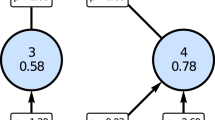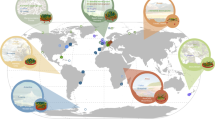Abstract
Theoretical ecology is largely founded on the principle of mass action, in which uncoordinated populations of predators and prey move in a random and well-mixed fashion across a featureless landscape. The conceptual core of this body of theory is the functional response, predicting the rate of prey consumption by individual predators as a function of predator and/or prey densities1,2,3,4,5. This assumption is seriously violated in many ecosystems in which predators and/or prey form social groups. Here we develop a new set of group-dependent functional responses to consider the ecological implications of sociality and apply the model to the Serengeti ecosystem. All of the prey species typically captured by Serengeti lions (Panthera leo) are gregarious, exhibiting nonlinear relationships between prey-group density and population density. The observed patterns of group formation profoundly reduce food intake rates below the levels expected under random mixing, having as strong an impact on intake rates as the seasonal migratory behaviour of the herbivores. A dynamical system model parameterized for the Serengeti ecosystem (using wildebeest (Connochaetes taurinus) as a well-studied example) shows that grouping strongly stabilizes interactions between lions and wildebeest. Our results suggest that social groups rather than individuals are the basic building blocks around which predator–prey interactions should be modelled and that group formation may provide the underlying stability of many ecosystems.
This is a preview of subscription content, access via your institution
Access options
Subscribe to this journal
Receive 51 print issues and online access
$199.00 per year
only $3.90 per issue
Buy this article
- Purchase on Springer Link
- Instant access to full article PDF
Prices may be subject to local taxes which are calculated during checkout




Similar content being viewed by others
References
Holling, C. S. The components of predation as revealed by a study of small-mammal predation of the European pine sawfly. Can. Entomol. 91, 293–320 (1959)
Arditi, R. & Ginzburg, L. R. Coupling in predator–prey dynamics: ratio-dependence. J. Theor. Biol. 139, 311–326 (1989)
Cosner, C., DeAngelis, D. L., Ault, J. S. & Olson, D. B. Effects of spatial grouping on the functional response of predators. Theor. Popul. Biol. 56, 65–75 (1999)
Jeschke, J. M., Kopp, M. & Tollrian, R. Predator functional responses: discriminating between handling and digesting prey. Ecol. Monogr. 72, 95–112 (2002)
Abrams, P. A. & Ginzburg, L. R. The nature of predation: prey dependent, ratio dependent, or neither? Trends Ecol. Evol. 15, 337–341 (2000)
Packer, C. et al. Ecological change, group territoriality, and population dynamics in Serengeti lions. Science 307, 390–393 (2005)
McCauley, E., Wilson, W. & de Roos, A. M. Dynamics of age-structured and spatially-structured predator–prey interactions: individual-based models and population-level formulations. Am. Nat. 142, 412–442 (1993)
Nisbet, R. M., de Roos, A. M., Wilson, W. G. & Snyder, R. E. Discrete consumers, small scale resource heterogeneity, and population stability. Ecol. Lett. 1, 34–37 (1998)
Donalson, D. D. & Nisbet, R. M. Population dynamics and spatial scale: effects of system size on population persistence. Ecology 80, 2492–2507 (1999)
Keeling, M. J., Wilson, H. B. & Pacala, S. W. Reinterpreting space, time lags, and functional responses in ecological models. Science 290, 1758–1761 (2000)
Pascual, M., Mazzega, P. & Levin, S. A. Oscillatory dynamics and spatial scale: the role of noise and unresolved pattern. Ecology 82, 2357–2369 (2001)
Hosseini, P. R. How localized consumption stabilizes predator–prey systems with finite frequency of mixing. Am. Nat. 161, 567–585 (2003)
Nachman, G. A functional response model of a predator population foraging in a patchy habitat. J. Anim. Ecol. 75, 948–958 (2006)
Cantrell, R. S. & Cosner, C. The effect of spatial heterogeneity on population dynamics. J. Math. Biol. 29, 315–338 (2001)
Packer, C. & Ruttan, L. M. The evolution of cooperative hunting. Am. Nat. 132, 159–198 (1988)
Scheel, D. & Packer, C. Group hunting behaviour of lions: a search for cooperation. Anim. Behav. 41, 697–709 (1991)
Packer, C., Scheel, D. & Pusey, A. E. Why lions form groups: food is not enough. Am. Nat. 136, 1–19 (1990)
McComb, K. E., Packer, C. & Pusey, A. E. Roaring and numerical assessment in contests between groups of female lions Panthera leo . Anim. Behav. 47, 379–387 (1994)
Grinnell, J., Packer, C. & Pusey, A. E. Cooperation in male lions: kinship, reciprocity or mutualism? Anim. Behav. 49, 95–105 (1995)
Fryxell, J. M., Greever, J. & Sinclair, A. R. E. Why are migratory ungulates so abundant? Am. Nat. 131, 781–798 (1988)
Mduma, S. A. R., Sinclair, A. R. E. & Hilborn, R. Food regulates the Serengeti wildebeest population: a 40-year record. J. Anim. Ecol. 68, 1101–1122 (1999)
Turchin, P. Complex Population Dynamics (Princeton Univ. Press, Princeton, NJ, 2003)
Scheel, D. Profitability, encounter rates, and prey choice of African lions. Behav. Ecol. 4, 90–97 (1993)
Elliott, J. P., Cowan, I., McT & Holling, C. S. Prey capture by the African lion. Can. J. Zool. 55, 1811–1828 (1977)
Rosenzweig, M. L. Paradox of enrichment—destabilization of exploitation ecosystems in ecological time. Science 171, 385–387 (1971)
Rosenzweig, M. L. & MacArthur, R. H. Graphical representation and stability conditions of predator–prey interactions. Am. Nat. 97, 209–223 (1963)
Sinclair, A. R. E., Fryxell, J. M. & Caughley, G. Wildlife Ecology, Conservation, and Management (Blackwell, Oxford, 2006)
Yodzis, P. Introduction to Theoretical Ecology (Harper & Row, New York, 1989)
Hastings, A. Population Biology: Concepts and Models (Springer, New York, 1997)
Mols, C. M. M. et al. Central assumptions of predator–prey models fail in a semi-natural experimental system. Proc. R. Soc. Lond. B 271 (Supplement). S85–S87 (2004)
Acknowledgements
We thank the many individuals who have assisted with Serengeti population monitoring over the decades. J.M.F. thanks the Visitor’s Programme of the Centre for Population Biology, Imperial College London, for logistic support during the preparation of this work. This work was supported by Discovery Grants to J.M.F. and A.R.E.S. from the Natural Sciences and Engineering Research Council of Canada, and by NSF Grants for Long-Term Research in Environmental Biology and Biocomplexity to C.P.
Author Contributions Field data used for this paper came from long-term collaborative studies by J.M.F., C.P. and A.R.E.S., with statistical analysis of the data by J.M.F. and A.M. Models were developed and analysed by J.M.F. All four authors participated in discussion of the results at a workshop and contributed to manuscript preparation.
Author information
Authors and Affiliations
Corresponding author
Ethics declarations
Competing interests
The authors declare no competing financial interests.
Supplementary information
Supplementary Information
The file contains Supplementary Table 1 (listing the parameters for curves shown in Fig. 1), Supplementary Figure 1 (showing seasonal variation in wildebeest group density and number of wildebeest groups encountered during censuses), and Supplementary Equations (listing equations for population equilibria and community matrix coefficients used for local stability analysis). (PDF 216 kb)
Rights and permissions
About this article
Cite this article
Fryxell, J., Mosser, A., Sinclair, A. et al. Group formation stabilizes predator–prey dynamics. Nature 449, 1041–1043 (2007). https://doi.org/10.1038/nature06177
Received:
Accepted:
Issue Date:
DOI: https://doi.org/10.1038/nature06177
This article is cited by
-
Pathways towards coexistence with large carnivores in production systems
Agriculture and Human Values (2022)
-
Collective behaviour can stabilize ecosystems
Nature Ecology & Evolution (2021)
-
The online competition between pro- and anti-vaccination views
Nature (2020)
-
Iterative evolution of large-bodied hypercarnivory in canids benefits species but not clades
Communications Biology (2020)
-
Ecological Consequences of Animal Migration: Prey Partial Migration Affects Predator Ecology and Prey Communities
Ecosystems (2020)
Comments
By submitting a comment you agree to abide by our Terms and Community Guidelines. If you find something abusive or that does not comply with our terms or guidelines please flag it as inappropriate.



